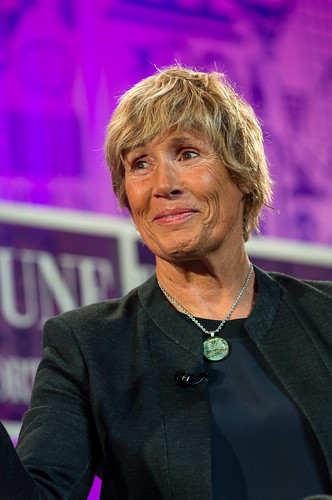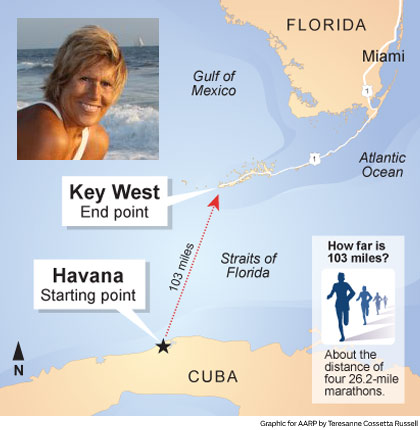2.3: Question Practice: Profile Diana Nyad
- Page ID
- 63238
Diana Nyad
Read the profile of Diana Nyad. Then practice composing questions about the profile.
Pre-reading Questions
Have you ever swum in the ocean? What are some dangers of swimming in the ocean? What is the farthest a human can swim?
Alternative Pre-reading Activity
Diana Nyad’s TED talk is available at this link
Diana Nyad Profile
Diana Nyad is the first person to swim from Havana, Cuba to Florida without a shark cage. She swam 110 miles (180 kilometers) and fifty-three hours. She was 64 years old when she accomplished her goal.
How did she do it?
Nyad attempted the swim five times from 2010 to 2013, and did not succeed until her fifth try in 2013. Each time she tried, she had to stop because of storms, jellyfish stings, asthma and shoulder pain. On Sept 2, 2013, she reached her goal despite these setbacks.
She trained by swimming eight to fourteen hours in the ocean every other week. While she was training, she gathered a team of about 35 people. These people helped her while she was swimming. One person paddled beside her in a kayak and used a device to keep sharks away from her. Others helped her put on a suit to keep jellyfish from stinging her. In order to help her swim in a straight line, her team dragged a streamer during the day and LED lights at night behind a boat and she followed them. To keep her mind busy while she was swimming, she thought about books and movies, counted and sang.
When asked about her motivation, she answered, "Because I'd like to prove to the other 60 year-olds that it is never too late to start your dreams."
Question Practice
Use the wh-questions words who, what, when, why, where, how far, how old, how many times to fill in the blanks.
Diana Nyad is the first person to swim from Cuba to Florida without a shark cage.
__________ is the first person to swim from Cuba to Florida without a shark cage?
She swam 110 miles.
_____________did she swim?
She was 64 years old.
______________ was she?
Nyad attempted the swim five times.
___________________did she attempt the swim?
On September 2, 2013, she reached her goal.
__________________ did she reach her goal?
Each time she tried, she had to stop because of storms, jellyfish stings, asthma, and shoulder pain.
______________did she have to stop?
She trained by swimming eight to fourteen hours in the ocean every other week.
_____________ did she train?
In order to help her swim in a straight line, her team dragged streamers behind the boat.
___________________ did her team drag streamers behind the boat.
To keep her mind busy, she thought about books and movies, counted and sang.
_________did she keep her mind busy?
She gathered a team of 35 people.
________________ people were on her team?



